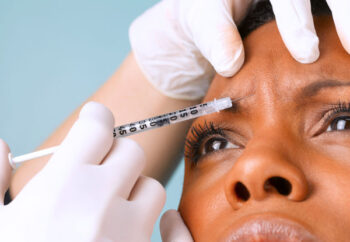By Sayer Ji
Contributing writer for Wake Up World
Botox injections use an extremely diluted form of the deadly botulinum toxin to paralyze facial muscles and smooth wrinkles. But emerging research suggests routinely paralyzing the very muscles essential for expressing the full range and depth of human emotions may hamper social attunement, empathy, and the ability to intuitively communicate and read complex feelings over time. As natural alternatives arise, it may be prudent to reconsider this popular ‘wrinkle treatment’ given these subtle psychological and neurological implications.
With millions of Botox injections administered annually for cosmetic and therapeutic purposes, the botulinum neurotoxin largely enjoys reputation as a safe, well-tolerated intervention.1 Yet emerging science reveals potentially concerning neurological and psychological implications of routinely paralyzing facial muscles that could impact emotional processing and empathy.2 An abundance of caution warrants that we reevaluate the unintended, adverse effects of this popular ‘anti-aging’ intervention.
What exactly does “Botox” contain? It hails from the same botulinum toxin that causes lethal foodborne botulism, produced by Clostridium bacteria. In tiny injected amounts, botulinum toxin partially paralyzes muscles by blocking neurotransmitter acetylcholine’s release, notably relaxing dynamic wrinkles. Though the powerful poison is roughly the deadliest substance known, internalizing the toxin protein generates targeted local effects.
Still, research documents around a thousand mostly temporary yet unpleasant reactions from approved cosmetic Botox between 1989-2003 including fatigue, pain, nausea, headache and flu-like illness.3 More seriously, muscle weakness can spread causing disabilities requiring hospitalization in rare cases. The same neurotoxin preventing nerve-muscle communication for smoothing skin could also seep into adjacent nerves or blood circulation.

But perhaps the most insidious consequences of repeatedly paralyzing one’s emotional musculoskeletal “keyboard” emerge subtly over time. The structured somatic experiencing pioneer Peter Levine discusses muscles’ critical role conveying social safety cues, allowing vulnerability by signaling we “have each other’s back.” Numbed faces hamper intuitively reading complex feelings to connect and empathize.
Supporting this community health perspective, a 2020 paper in Frontiers of Psychology entitled “Does Botox fundamentally affect one’s perception of emotion?” extensively reviews evidence on Botox’ bodily feedback mechanisms. Through the “embodied simulation” theory, subtle facial mimicry and feedback to our neural and endocrine systems shapes emotional interpretation, both conscious and unconscious. The author writes:
“As a toxin that temporarily paralyzes muscle-activating nerves, it is unsurprising that Botox injections affect embodied simulation. Through paralysis of facial muscles, Botox inhibits facial mimicry ability which … fundamentally impairs recognition of basic emotions from faces.”2
This data suggests Botox weakens sensing emotions in ourselves and social partners, disconnecting us from primal cues weaving the human tapestry. Losing emotional attunement bears profound societal and relational consequences beyond chasing youthful appearance. And safer botanical alternatives like aloe, cocoa, green tea and homeopathy now prove just as effective at tightening mature skin and smoothing wrinkles.4

Perhaps most dramatically highlighting the profound ‘anti-aging’ results of simply removing toxicity, an Italian clinical study demonstrated that quitting cigarette smoking for 9 months reversed participants’ skin age by up to 13 years – from 9 years older appearance than chronological age down to 4 years younger looking.1 The chemical assault wrought by continual smoking clearly ages skin prematurely. Can you imagine what would happen if the hundreds of other toxic exposures we confront regularly were significantly reduced, and how that would positive affect you skin’s biological age?
Carefully examining one’s lifestyle and diet to reduce exposure with toxins, pollutants, allergens, endocrine disruptors, heavy metals and pesticides would profoundly improve health and longevity. For the skin is a mirror of both external and internal exposures and influences, most of which we have some control in minimzing or altogether eliminating.5
With toxicity concerns compounding impacts on empathy, perhaps the time has come to reconsider routine Botox injections that paralyze the complex web of facial signals and signaling behaviors. By working holistically with balanced nutrition, hydration, facial massage, collagen support and rest rather than fighting our biology with injected toxins we can age both gracefully and non-prematurely. And, in some cases, we can even reverse our biological age by incorporating time-tested, and newly clinically valid natural approaches like aloe vera.
Learn more by reading: Research: A Tsp. of Aloe Daily Reverses Signs of Skin Aging
Learn more by reading: Botox’s Ugly ‘Side Effects’ Run Deeper Than Skin, Alter Mind & Numb Emotion
Learn more by reading: Skin Aging.
References:
1. Carruthers JD, Lowe NJ, Menter MA, Gibson J, Eadie N. Botox Glabellar Lines II Study Group. Double-blind, placebo-controlled study of the safety and efficacy of botulinum toxin type A in patients with glabellar lines. Plast Reconstr Surg. 2003;112(4):1089-98.
2. Sajid MI. Does Botox Fundamentally Affect One’s Perception of Emotion? A Review of the Evidence. Front Psychol. 2020;11:569.
3. Hiestand EN, Martin S. Botox: applications beyond wrinkles. J Ark Med Soc. 2004;101(2):22-5.
4. Perkins MA, Card JP, Osterhout DJ. A Review of the Beneficial Effects of Hydrolysed Collagen as a Nutraceutical on Skin Properties and Ageing. Nutrients. 2021;13(8):2773.
5. Riccarda Serri, Maria Concetta Romano, Adele Sparavigna. “Quitting smoking rejuvenates the skin”: results of a pilot project on smoking cessation conducted in Milan, Italy. Skinmed. 2010 Jan-Feb;8(1):23-9. PMID: 20839421
About the author:
Sayer Ji is the founder of Greenmedinfo.com, a reviewer at the International Journal of Human Nutrition and Functional Medicine, Co-founder and CEO of Systome Biomed, Vice Chairman of the Board of the National Health Federation, and Steering Committee Member of the Global Non-GMO Foundation.
© 2020 GreenMedInfo LLC. This work is reproduced and distributed with the permission of GreenMedInfo LLC. Want to learn more from GreenMedInfo? Sign up for their newsletter here.

If you've ever found value in our articles, we'd greatly appreciate your support by purchasing Mindful Meditation Techniques for Kids - A Practical Guide for Adults to Empower Kids with the Gift of Inner Peace and Resilience for Life.
In the spirit of mindfulness, we encourage you to choose the paperback version. Delve into its pages away from screen glare and notifications, allowing yourself to fully immerse in the transformative practices within. The physical book enriches the learning process and serves as a tangible commitment to mindfulness, easily shared among family and friends.
Over the past few years, Wake Up World has faced significant online censorship, impacting our financial ability to stay online. Instead of soliciting donations, we're exploring win-win solutions with our readers to remain financially viable. Moving into book publishing, we hope to secure ongoing funds to continue our mission. With over 8,500 articles published in the past 13 years, we are committed to keeping our content free and accessible to everyone, without resorting to a paywall.









